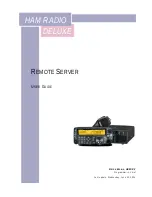
Kontron IP Network Server NSC2U
December 2009
Product Guide, rev. 1.421
Features—NSC2U Server
• The second riser card slot, a low-profile riser card, supports low-profile PCIe add-in
boards.
See
Section 4.2, “Installing or Replacing a PCI Add-in Card” on page 51
, for
instructions describing how to install a PCI-X or PCIe add-in card. After the add-in cards
are installed, the riser assembly is plugged back into the system and the I/O brackets
of all the add-in cards are accessible through the rear panel of the server chassis.
2.8.1
Full-height PCI-X/PCIe Riser Card
The PCI-X/PCIe riser card plugs into the super slot on the the server board. For PCI-X
add-in cards, the super slot riser card implements a 64-bit PCI-X slot with bus speeds
of 66 MHz, 100 MHz, or 133 MHz. For PCIe cards, the super slot has eight PCIe lanes
which can be used for a single x8 add-in card or for one or two x4 or x1 add-in cards.
See
for the supported configurations. For detailed information about the
pinouts and electrical specifications, see the
Kontron IP Network Server NSC2U
Technical Product Specification
.
2.8.2
Low-profile PCIe Riser Card
The low-profile PCIe riser card plugs into the server board and supports the connection
of low-profile PCIe add-in cards only. The low-profile PCIe riser card implements two
×4 link interfaces. Up to two low-profile PCIe add-in cards can be installed. See
for the supported configurations. For detailed information about the pinouts and
electrical specifications, see the
Kontron IP Network Server NSC2U Technical Product
Specification
.
2.9
Power Supply
The power subsystem has up to two power supply modules capable of operating in
redundant mode and a Power Distribution Board (PDB). A power supply filler panel for
the empty power supply site is supplied for systems without redundancy.
The power supply is rated for 600W output capability in full AC (or DC) input voltage
range.
2.10
System Cooling
There are three cooling areas (domains) in the NSC2U Server system:
• domain 1 - CPU 1 and memory; see area outlined in blue in
• domain 2 - CPU 2, chipset, and any low-profile PCIe add-in cards; see area outlined
in green in
• domain 3 - any full length PCI-X or PCIe addin cards; see area outlined in red in
















































